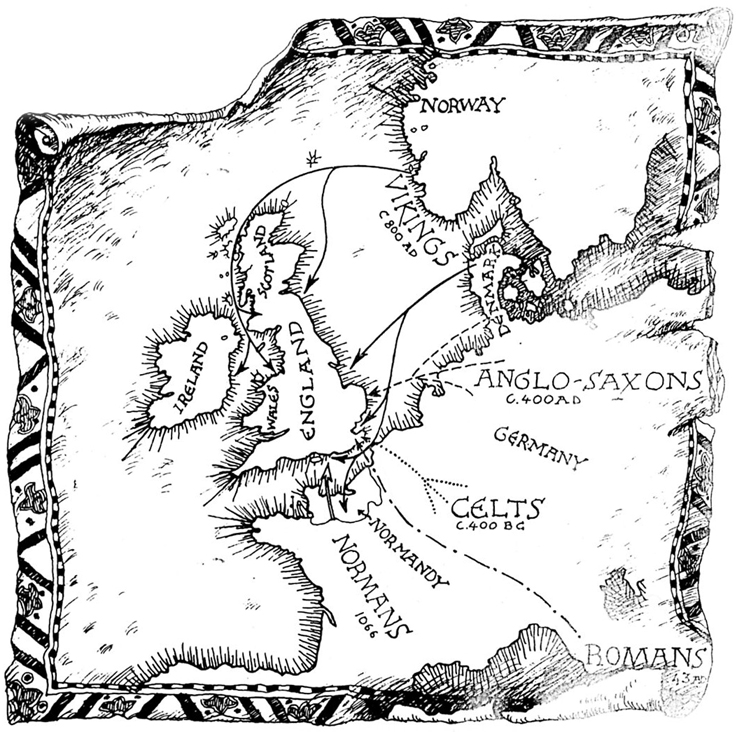1066
The year was 1065 and in
London the English king,
Edward the Confessor, was dying. He had no children and three men claimed the
throne of England: Harold Godwin,
the Earl of Wessex, William, the Duke of Normandy and
Harald Hardraada, the King
of Norway.
Harold Godwin was the most
important of the Anglo-Saxon lords. Edward had been a weak king and Harold had
been the real ruler of England for many years.
When Edward died at the end of 1065, Harold was crowned king.
When the news reached Duke
William, he was very angry. William was the Duke of Normandy in northern France and he was
Edward's cousin. Edward had grown up in Normandy and he had
promised William the throne. Duke William was tall and strong and he was a
famous soldier.
But if William was tall, Harald Hardraada was even taller.
He was a giant, almost seven feet tall. Hardraada's
ancestors had been kings of England before Edward and
now he wanted the throne for himself.
The first challenge to King
Harold Godwin came from the north. In 1066 at the end of the summer, Harald Hardraada landed in
north-eastern England. Godwin inarched north with his army.
The Anglo-Saxon and Norwegian
armies met at Stamford
Bridge near the city of
York. Before the
battle, Hardraada asked King Harold: 'How much of England will you give me?'
'Seven feet, Godwin replied, enough for your grave.'
And that was all that Hardraada received. By the end of the day he was dead and
the Norwegian army had been destroyed. But, while Harold and his soldiers were
resting after the battle, news arrived from London: Duke William had
landed on the south coast near the town of Hastings.
William stayed near
Hastings and waited for
Harold Godwin. The English king returned to London, collected a new
army and marched to Hastings. They stopped on a
hill and the battle began. The Anglo-Saxons fought on foot, but the
Normans were on horses.
The Normans attacked but the
Anglo-Saxon soldiers were safe on the top of the hill. They pushed the
Normans back. Then the
Normans pretended to run
away. Some of the Anglo-Saxons chased them down the hill. But the Norman
knights turned round and killed them.
Harold and most of his army
had stayed on the hill. But then the Norman archers attacked. They fired their
arrows into the air. King Harold looked up and an arrow hit him in the eye. The
last Angle-Saxon king was and Duke William had won.
After the Battle of Hastings,
William marched to London and was crowned
king of England. He is now called
William the Conqueror and 1066 is the most famous date in English history. It was
a turning point for English history and the English language.
CULTURE SPOT
Invaders

The Norman Conquest was the
last successful attack on Britain, but in the
centuries before 1066, different groups of people had invaded the British Isles.
In about 400 BC the Celts came
to Britain. The Celts weren't
the first people to come to Britain, but we don't know
much about the earlier inhabitants.
In ad 43 the Romans conquered
southern Britain. They didn't
conquer Scotland. The Roman
Emperor, Hadrian, built a wall to keep the wild Scottish tribes out. Hadrian's Wall was the northern
limit of the Roman Empire.
The Romans stayed in Britain for over 300
years, but around ad 400 tribes from Germany started to attack
the Empire. The Romans left Britain. People from
Holland, Northern Germany and Denmark attacked and
conquered England. These people are
called Anglo-Saxons. The name England comes from
'Angle-land', The Anglo-Saxons pushed the Celts into Scotland, Wales and Ireland.
Four hundred years later, the
Vikings attacked Britain. The Vikings came
from Norway and Denmark. The English kings
gave the Vikings the north-eastern half of England. The Vikings also
attacked France. The French king
gave them land, too. It was called 'the land of the Northman of Normandy'.
COMPARISON
• Where did your people come
from?
• Did the Celts, Romans,
German tribes or Vikings invade your country, too?
